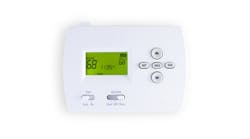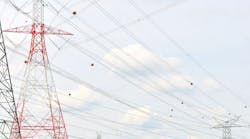An important aspect of maintaining a transformer is ensuring that it has low moisture content. New dry transformers have a moisture content of approximately 0.3% to 0.7% in the solid insulation.
Traditionally, utilities have used a chemical method in which the moisture in oil is measured using the Karl Fischer titration, and equilibrium curves are used to correlate the moisture in oil to the moisture content in paper insulation. This method is easy to perform; however, it has its shortcomings such as the transformer must be at equilibrium to obtain accurate results. It's important to recognize the equilibrium curves used to correlate the moisture in the oil to the moisture content in the paper insulation are only applicable for new transformers, not aged units.
Delmarva Power, a subsidiary of Pepco Holdings Inc., which provides power to 501,000 electric delivery customers in Delaware and the Delmarva peninsula in the United States, recently invested in the DIRANA. The DIRANA device, manufactured by OMICRON electronics, measures the moisture content in the paper insulation of transformers by measuring the dielectric frequency response (DFR) of the solid insulation. The DFR is a unique characteristic of the insulation system. The increased moisture content of the insulation results in a changed dielectric model and, thus, a changed dielectric response. By measuring the dielectric response of apparatus in a wide frequency range, the moisture content can be assessed and the insulation condition accurately diagnosed.
Moisture Content
Moisture causes three dangerous effects in transformers:
-
Degrades the paper and accelerates insulation aging
-
Reduces the dielectric strength of the oil and paper
-
Lowers bubbling onset temperature (which decreases dielectric strength and provides partial discharge inception).
The first effect can shorten the life expectancy of a transformer considerably. The last two effects can result in the premature failure of an otherwise healthy transformer.
Water in transformers comes from four sources: residual water, water from cellulose aging, water through leaky seals or repairs, and water due to breathing. Therefore, even in the case of a non-breathing transformer, moisture can reach critical levels.
Test Results
DFR tests are performed as a traditional ungrounded specimen test made from the high-voltage winding to the low-voltage winding (CHL) for a two-winding transformer. The CHL insulation is used for the analysis, as the inter-winding insulation contains the most cellulose insulation material, and moisture predominately resides in the paper and not the oil.
The DFR test connections and modes are the same as used in a traditional 50/60-Hz transformer insulation power factor test with the difference being the DFR test is performed at a low voltage (up to 200-V peak) and at frequencies from 0.1-mHz to 1-kHz. Supplemental grounded specimen tests can be performed, such as CH and CL, however, external influences can affect the measurements.
Delmarva has been using the DIRANA as part of its condition-based maintenance program. The utility recently used this state-of-the-art technology on assessing the condition of a McGraw-Edison transformer. Manufactured in 1969, the transformer was rated at 12 MVA. Delmarva had performed 10-kV, 60-Hz power factor measurements on the transformer, and the power factor for the CHL insulation was elevated at 0.84%.
At a later date, the utility performed a DFR measurement on the CHL insulation to determine if the elevated power factor was due to moisture. The DFR test results indicated the transformer had 3.7% moisture content in its solid insulation. The test verified the elevated 60-Hz power factor measurements were attributed to high moisture content in the transformer's paper insulation.
It is well documented that a transformer with more than 3% moisture content has a significant decrease in breakdown voltage and the turn-to-turn strength of the insulation is substantially reduced. This greatly increases the risk of failure. Based on the DFR test results, Delmarva decided to dry the transformer using a vacuum process to remove the moisture from the paper insulation.
High moisture content also critically reduces the life of a transformer. Cellulose makes up a major part of the insulation system on a transformer. Water, along with high temperatures, accelerates the aging of paper by a chemical process called hydrolysis, during which the bonds between glucose rings is broken, thereby decreasing the mechanical strength of the paper and decreasing the expected transformer life. A transformer operating at 70°C (158°F) with 1% moisture content has a life expectancy of approximately 100 years. That same transformer operating at 70°C with 4% moisture content has a life expectancy of 10 years. This is a significant reduction in life expectancy.
Going Forward
DFR is the latest technology on the market to determine moisture content in a transformer's paper insulation. Unlike standard test methods such as moisture in oil or moisture saturation tests, DFR does not require the transformer to be at equilibrium. Delmarva performs DFR testing to ensure its transformer insulation is in an acceptably dry condition.
This proactive approach will prevent future unplanned outages. This approach also avoids costly transformer replacement due to high moisture caused by premature failure. Delmarva will continue to use this technology for troubleshooting, and, in the future, it hopes to start applying this method as an acceptance test for new transformers.
Acknowledgement
The author recognizes Mary Foster of OMICRON electronics USA for her technical guidance, which was pivotal in the development of this article.
Jacob Kuruvilla ([email protected]) is a consulting engineer in the electrical maintenance group at Delmarva Power. Kuruvilla has 24 years of power industry experience. He holds a BSEE degree from Kerala University in Kerala, India, and a MBA degree from Drexel University in Pennsylvania, U.S.
Companies mentioned:
Delmarva Power | www.delmarva.com
OMICRON | www.omicron.at

